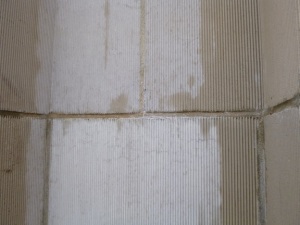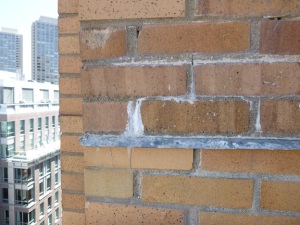Each week we’re bringing you an in-depth look at one of the standard conditions we encounter and document during inspections of buildings and civil structures.
Part 4: Efflorescence and Leached Salts
Efflorescence is a soft white deposit on the surface of masonry caused by water moving through the material and bringing dissolved minerals to the surface. The term leached salts refers to hard encrustations of salts deposited at the surface of masonry, often at joints or cracks. In extreme cases, leached salts can form stalactites. Leached salts may also be known as salt crusts.
Efflorescence and leached salts can occur in brick, stone, concrete, or terra cotta, or at the mortar joints of masonry construction. As water moves through these materials, it dissolves naturally-occuring salts and minerals, which are deposited at the surface of the material as the water evaporates. This usually results from water infiltration into otherwise-sound masonry. Efflorescence can also form as a result of concrete curing, as water and dissolved salts are driven out of the finished product. Poor concrete curing practices, inappropriate concrete mixtures, poor quality brick, and inappropriate mortars can contribute to the problem.
Next in this series: Surface loss
Click here to see all posts in this series.
Click here for an index of all posts in this series, or download a pdf of the complete series.


